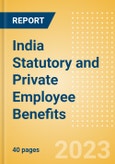The report provides in-depth industry analysis, information, and insights into employee benefits in India, including an overview of the state and compulsory benefits in India, detailed information about the private benefits in India, insights on various central institutions responsible for the administration of the different branches of social security and the regulatory framework of the employee benefits in India.
The Indian social security system only covers employees in the organized sector, which accounts for less than 10% of the country's workforce. As the unorganized sector is continuously growing the Government of India has launched several social security measures related to healthcare, pension, and direct cash transfer schemes for people who do not have access to any formal scheme.
The Indian social security system only covers employees in the organized sector, which accounts for less than 10% of the country's workforce. As the unorganized sector is continuously growing the Government of India has launched several social security measures related to healthcare, pension, and direct cash transfer schemes for people who do not have access to any formal scheme.
Key Highlights
- The Employees' State Insurance Act 1948 (ESI Act), The Employees' Provident Funds & Miscellaneous Provisions Act, 1952 (EPF & MP Act), The Employees' Compensation Act, 1923 (WC Act), The Maternity Benefit Act, 1961 (MB Act), and The Payment of Gratuity Act, 1972 (PG Act) are responsible for the functioning of the overall social security system
- A person's national insurance contribution is determined based on their income
- An insured person who is unemployed or unable to work and whose benefits have been exhausted is entitled to a credited contribution
- In India, employers provide voluntary retirement benefits to their employees through Atal Pension Yojana and Swavalamban scheme
Scope
This report provides a detailed analysis of employee benefits in India:- It offers a detailed analysis of the key government-sponsored employee benefits, along with private benefits
- It covers an exhaustive list of employee benefits, including retirement benefits, death in service, long-term disability benefits, medical benefits, workmen's compensation insurance, maternity and paternity benefits, unemployment benefits, leaves and holidays and private benefits
- It highlights the economic and regulatory situations relating to employee benefits in India
Reasons to Buy
- Make strategic decisions using in-depth information related to employee benefits in the country
- Assess employee benefits of the market, including state and compulsory benefits and private benefits
- Gain insights into the key employee benefit schemes offered by private employers in the country
- Gain insights into key organizations governing employee benefits market, and their impact on companies
Table of Contents
1. Executive Summary3. Country Statistics4. Overview of Employee Benefits in India5. Regulations
2. Introduction
6. State and Compulsory Benefits
7. Private Benefits
List of Tables








